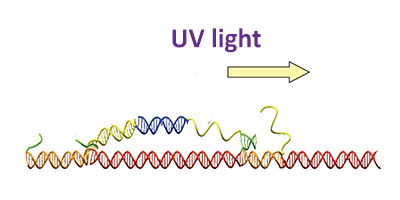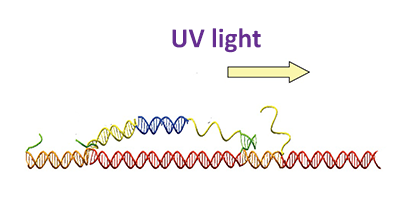Waste-Free Nanowalkers
Inspired by biomolecules that “walk” along cellular structures, scientists have developed a variety of different nanowalkers. But these man-made systems don’t follow exactly in nature’s footsteps yet. One drawback is that these machines tend to “burn their bridges” by chemically altering the track on which they have moved. They also leave waste products that can restrict their use in biomedical applications. Writing in Physical Review Letters, Juan Cheng, at the National University of Singapore, and colleagues report on a new DNA-based nanowalker design that moves in a particular direction through a purely physical, rather than chemical, mechanism. Driven by light, this two-legged motor does not produce any chemical waste.
The walker has two identical legs, each consisting of two distinct DNA strands that may be thought of as the “heel” and “toe.” The researchers constructed a corresponding DNA track with complementary “heelholds” and “toeholds.” A typical starting configuration has one back leg attached by its heel and one front leg attached by its toe. Exposure to light causes the back leg to release and the front leg to switch from a toe to heel attachment. The spacing on the track does not allow the released leg to reattach at its previous position. Instead, it eventually reorients and attaches its toe in front of the other leg, thus completing a cycle that can be repeated. The researchers used fluorescent dyes to track the walker’s motion in real time.
Artificial nanowalkers may one day carry loads on a nanoscale assembly line or shuttle compounds from one reaction station to the next in nanodevices for multistep organic synthesis. – Michael Schirber





